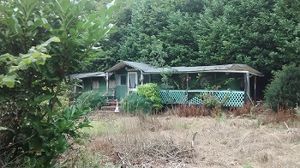Difference between revisions of "Wooden Shacks"
(update) |
(Add description of 'Plotlands' and YouTube with 8233. Edit link to archived plan) |
||
| Line 2: | Line 2: | ||
A notable feature of the [[Severn Valley]] landscape is the large number of wooden shacks, particularly on Hill Farm on the east bank and Hawkbatch Farm on the west bank between [[Northwood Halt]] and [[Folly Point]] with smaller numbers north of [[Arley]] at Bank Farm and at [[Highley]]. | A notable feature of the [[Severn Valley]] landscape is the large number of wooden shacks, particularly on Hill Farm on the east bank and Hawkbatch Farm on the west bank between [[Northwood Halt]] and [[Folly Point]] with smaller numbers north of [[Arley]] at Bank Farm and at [[Highley]]. | ||
| − | Most were built in the 1920s and '30s as holiday homes, with more being added in the 1940s until the introduction of the 1947 Town and Country Planning Act. Many are now permanently occupied. | + | '''Plotlands''' refer to small pieces of land laid out in regular plots on which a number of self-built settlements were established from the late 1800s and up to the Second World War, largely built outside the conventional planning system.<ref>[https://www.spatialagency.net/database/the.plotlanders 'Plotlands', spatialagency.net] (Retrieved 31 May 2024)</ref><ref>[https://englishbuildings.blogspot.com/2011/06/bewdley-worcestershire.html Wilkinson, Philip, 'Bewdley, Worcestershire', English Buildings blog, 5 June 2011] (Retrieved 31 May 2024)</ref> |
| + | |||
| + | Most around the SVR were built in the 1920s and '30s as holiday homes, with more being added in the 1940s until the introduction of the 1947 Town and Country Planning Act. Many are now permanently occupied. In the 2006 local plan there were 380 such shacks in total within the Wyre Forest District.<ref>[https://archive.wyreforestdc.gov.uk/media/106049/Adopted-Site-Allocations-and-Policies-LP-1-.pdf Wyre Forest District Council Local Plan 2006] Section 7.103</ref> | ||
It is likely that many were originally based on railway carriages, although after several decades of repairs and extensions, none of them retains any outward evidence of this. The last one recognisable as a railway carriage was demolished in early 2017. | It is likely that many were originally based on railway carriages, although after several decades of repairs and extensions, none of them retains any outward evidence of this. The last one recognisable as a railway carriage was demolished in early 2017. | ||
| Line 8: | Line 10: | ||
==References== | ==References== | ||
<references/> | <references/> | ||
| + | |||
| + | ==Links== | ||
| + | *[https://www.youtube.com/watch?v=CEeulyPsuOk Meades, Jonathan, Abroad in Britain TV series, BBC, Ep. 5 'Severn Heaven' (1990)] from 4:25 onwards. LMS [[48773|8233]] features briefly at around 23:00. | ||
==See also== | ==See also== | ||
[[From The Window]] | [[From The Window]] | ||
Revision as of 21:09, 31 May 2024
A notable feature of the Severn Valley landscape is the large number of wooden shacks, particularly on Hill Farm on the east bank and Hawkbatch Farm on the west bank between Northwood Halt and Folly Point with smaller numbers north of Arley at Bank Farm and at Highley.
Plotlands refer to small pieces of land laid out in regular plots on which a number of self-built settlements were established from the late 1800s and up to the Second World War, largely built outside the conventional planning system.[1][2]
Most around the SVRSevern Valley Railway were built in the 1920s and '30s as holiday homes, with more being added in the 1940s until the introduction of the 1947 Town and Country Planning Act. Many are now permanently occupied. In the 2006 local plan there were 380 such shacks in total within the Wyre Forest District.[3]
It is likely that many were originally based on railway carriages, although after several decades of repairs and extensions, none of them retains any outward evidence of this. The last one recognisable as a railway carriage was demolished in early 2017.
References
- ↑ 'Plotlands', spatialagency.net (Retrieved 31 May 2024)
- ↑ Wilkinson, Philip, 'Bewdley, Worcestershire', English Buildings blog, 5 June 2011 (Retrieved 31 May 2024)
- ↑ Wyre Forest District Council Local Plan 2006 Section 7.103
Links
- Meades, Jonathan, Abroad in Britain TV series, BBC, Ep. 5 'Severn Heaven' (1990) from 4:25 onwards. LMSLondon Midland & Scottish Railway 8233 features briefly at around 23:00.
